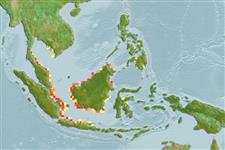Elasmobranchii (sharks and rays) >
Myliobatiformes (Stingrays) >
Dasyatidae (Stingrays) > Urogymninae
Etymology: Urogymnus: Greek, oura = tail + Greek, gymnos = naked (Ref. 45335); lobistoma: Name from Latin 'lobus' for elongated projection or protuberance and 'stoma' for mouth, refers to its protrusible, tubelike mouth.
More on authors: Manjaji-Matsumoto & Last.
Environment: milieu / climate zone / depth range / distribution range
Ecology
Marine; benthopelagic. Tropical
Indo-Malay Archipelago: from Sumatra to Borneo.
Size / Weight / Age
Maturity: Lm ? range ? - ? cm
Max length : 49.2 cm WD male/unsexed; (Ref. 58327); 100.0 cm WD (female)
Short description
Identification keys | Morphology | Morphometrics
This species belong to the 'uarnacoides' complex, characterized by the following: lateral disc shape with pectoral fin apices broadly rounded rather than narrowly rounded or angular; color plain (usually uniform light to dark brown dorsally, and pale or whitish ventrally with or without a dark margin; a long and slender whiplike tail and platelike denticles in a broad dorsal band in adults. This species differs from H. hortlei in having a highly protrusible mouth and a pelvic girdle with prominent lateral prepelvic processes (Ref. 58327).
An inshore species which I s probably with restricted distribution in brackish habitats that are associated with runoff from large rivers. Feeds on small fishes and prawns. Males mature at ca. 49 cm WD, females at ca. 70 cm WD; born at ca. 19 cm WD (Ref. 114953). Female maturity based on a pregnant female; males apparently smaller than females; full term pup 18.4 cm DW (Ref. 58327).
Life cycle and mating behavior
Maturity | Reproduction | Spawning | Eggs | Fecundity | Larvae
Manjaji-Matsumoto, B.M. and P.R. Last, 2006. Himantura lobistoma, a new whipray (Rajiformes: Dasyatidae) from Borneo, with comments on the status of Dasyatis microphthamus. Ichthyol. Res. 53(3):290-297. (Ref. 58327)
IUCN Red List Status (Ref. 130435: Version 2024-1)
Threat to humans
Harmless
Human uses
Tools
Special reports
Download XML
Internet sources
Estimates based on models
Preferred temperature (Ref.
123201): 28.2 - 29.1, mean 28.8 °C (based on 232 cells).
Phylogenetic diversity index (Ref.
82804): PD
50 = 0.5156 [Uniqueness, from 0.5 = low to 2.0 = high].
Bayesian length-weight: a=0.01023 (0.00486 - 0.02155), b=3.06 (2.87 - 3.25), in cm total length, based on LWR estimates for this (Sub)family-body shape (Ref.
93245).
Trophic level (Ref.
69278): 3.5 ±0.4 se; based on size and trophs of closest relatives
Fishing Vulnerability (Ref.
59153): Very high vulnerability (90 of 100).
